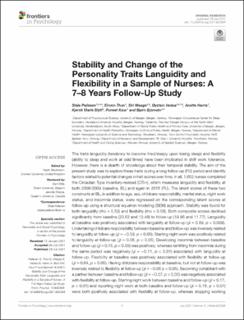| dc.description.abstract | The traits languidity (tendency to become tired/sleepy upon losing sleep) and flexibility (ability to sleep and work at odd times) have been implicated in shift work tolerance. However, there is a dearth of knowledge about their temporal stability. The aim of the present study was to explore these traits during a long follow-up (FU) period and identify factors related to potential changes in trait scores over time. In all, 1,652 nurses completed the Circadian Type Inventory-revised (CTI-r), which measures languidity and flexibility, at both 2008/2009 (baseline, BL) and again in 2016 (FU). The latent scores of these two constructs at BL, in addition to age, sex, childcare responsibility, marital status, night work status, and insomnia status, were regressed on the corresponding latent scores at follow-up using a structural equation modeling (SEM) approach. Stability was found for both languidity (rho = 0.59) and flexibility (rho = 0.58). Both composite scores declined significantly from baseline (20.62 and 12.48) to follow-up (19.96 and 11.77). Languidity at baseline was positively associated with languidity at follow-up (β = 0.89, p < 0.009). Undertaking childcare responsibility between baseline and follow-up was inversely related to languidity at follow-up (β = −0.09, p < 0.05). Starting night work was positively related to languidity at follow-up (β = 0.06, p < 0.05). Developing insomnia between baseline and follow-up (β = 0.15, p < 0.05) was positively, whereas remitting from insomnia during the same period was negatively (β = −0.11, p < 0.01) associated with languidity at follow-up. Flexibility at baseline was positively associated with flexibility at follow-up (β = 0.64, p < 0.05). Having childcare responsibility at baseline, but not at follow-up was inversely related to flexibility at follow-up (β = −0.05 p < 0.05). Becoming cohabitant with a partner between baseline and follow-up (β = −0.07, p < 0.05) was negatively associated with flexibility at follow-up. Starting night work between baseline and follow-up (β = 0.17, p < 0.01) and reporting night work at both baseline and follow-up (β = 0.18, p < 0.01) were both positively associated with flexibility at follow-up, whereas stopping working nights was negatively (β = −0.09, p < 0.05), associated with flexibility at follow-up. The personality traits languidity and flexibility show fairly high stability, albeit the mean scores were significantly reduced during the 7–8 years follow-up period. The results suggest that these personality traits are partly modifiable. | |
